定语从句 课件(共26张PPT)-2026届高三英语二轮复习
文档属性
| 名称 | 定语从句 课件(共26张PPT)-2026届高三英语二轮复习 | 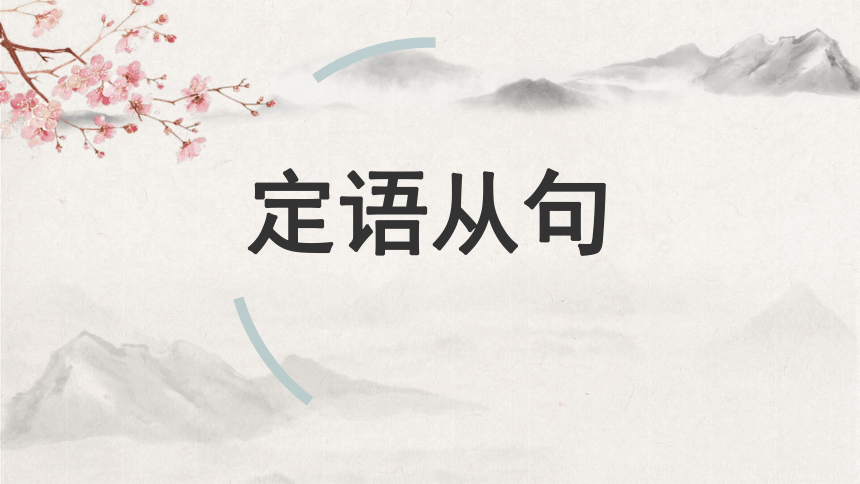 | |
| 格式 | pptx | ||
| 文件大小 | 485.2KB | ||
| 资源类型 | 教案 | ||
| 版本资源 | 通用版 | ||
| 科目 | 英语 | ||
| 更新时间 | 2025-07-17 07:49:34 | ||
图片预览

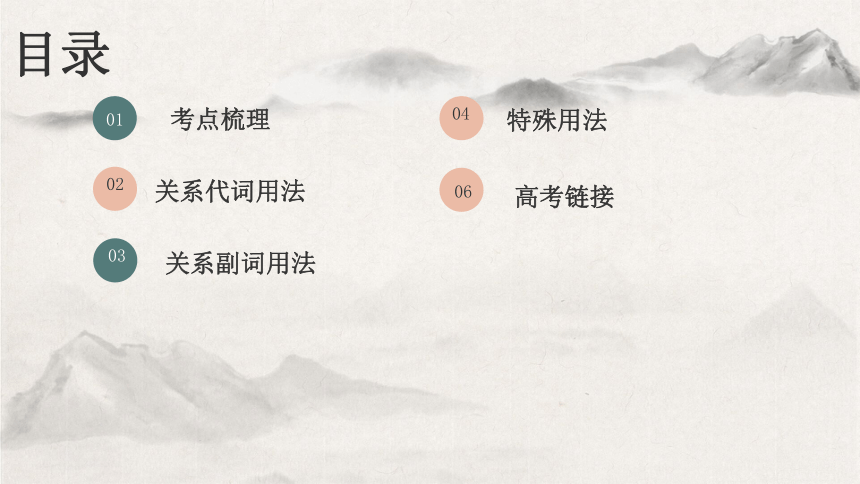
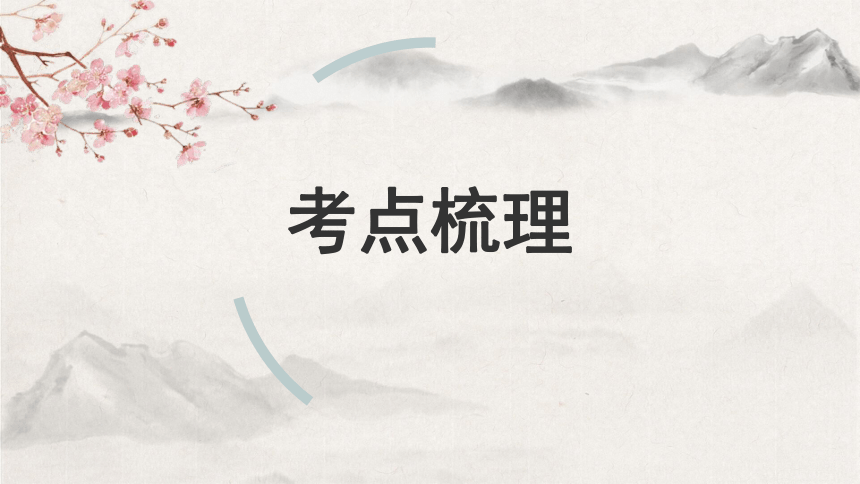
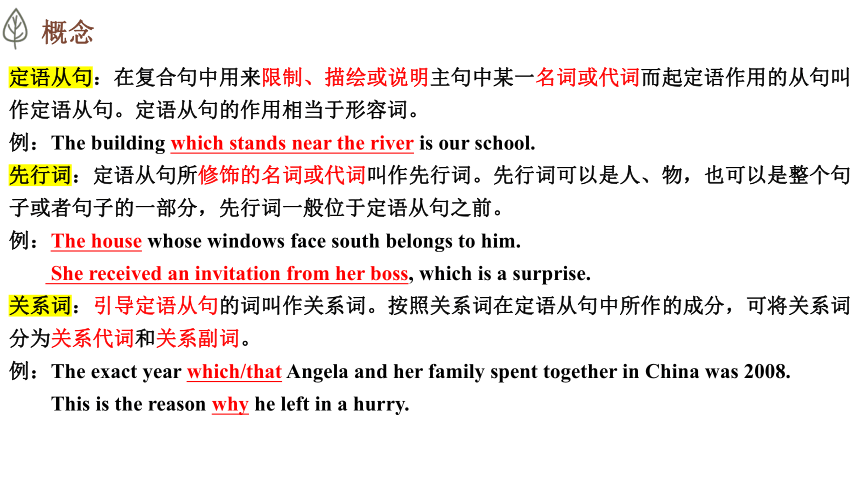
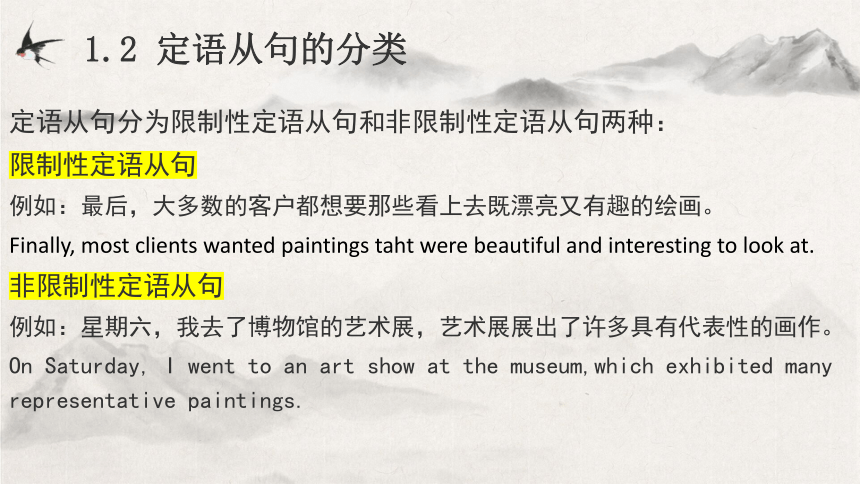

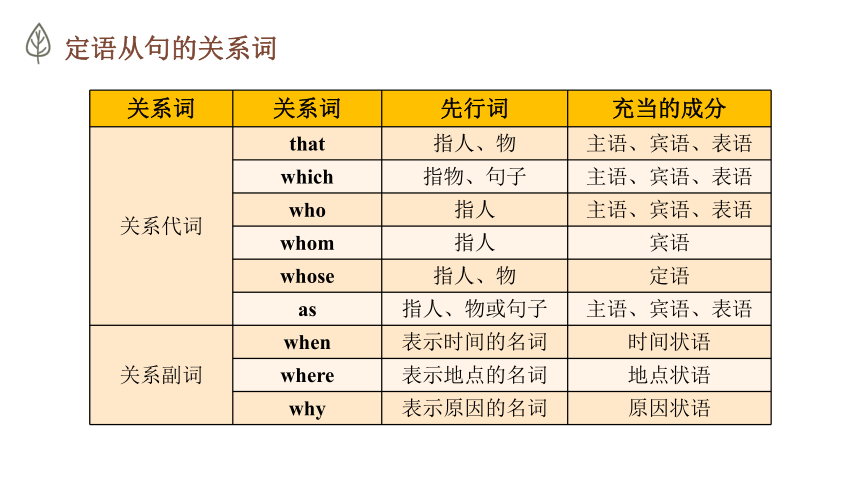
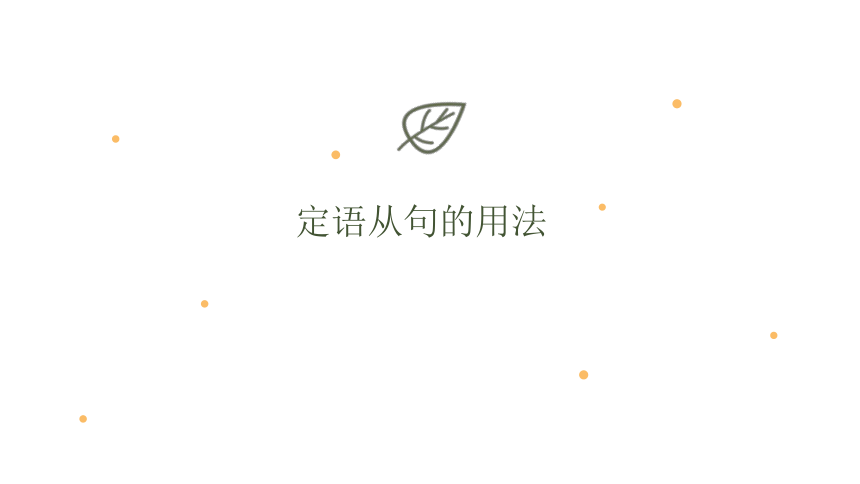
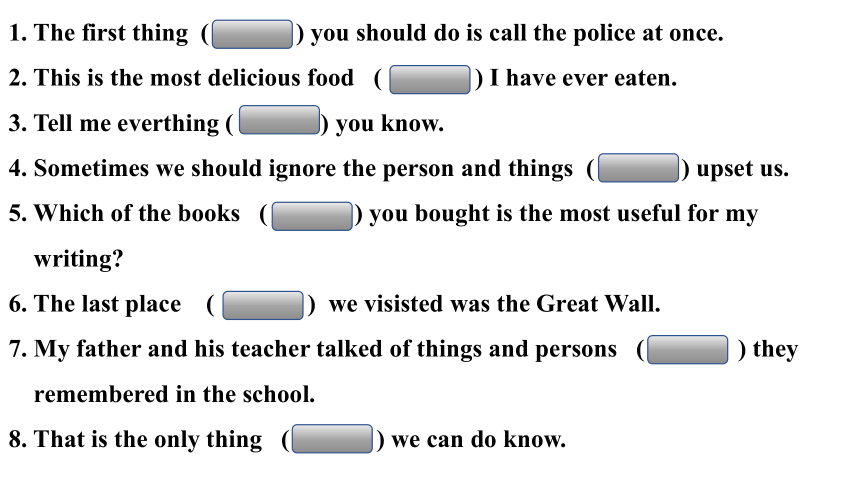
文档简介
(共26张PPT)
定语从句
目录
01
考点梳理
02
关系代词用法
03
关系副词用法
04
特殊用法
06
高考链接
考点梳理
定语从句:在复合句中用来限制、描绘或说明主句中某一名词或代词而起定语作用的从句叫作定语从句。定语从句的作用相当于形容词。
例:The building which stands near the river is our school.
先行词:定语从句所修饰的名词或代词叫作先行词。先行词可以是人、物,也可以是整个句子或者句子的一部分,先行词一般位于定语从句之前。
例:The house whose windows face south belongs to him.
She received an invitation from her boss, which is a surprise.
关系词:引导定语从句的词叫作关系词。按照关系词在定语从句中所作的成分,可将关系词分为关系代词和关系副词。
例:The exact year which/that Angela and her family spent together in China was 2008.
This is the reason why he left in a hurry.
概念
1.2 定语从句的分类
定语从句分为限制性定语从句和非限制性定语从句两种:
限制性定语从句
例如:最后,大多数的客户都想要那些看上去既漂亮又有趣的绘画。
Finally, most clients wanted paintings taht were beautiful and interesting to look at.
非限制性定语从句
例如:星期六,我去了博物馆的艺术展,艺术展展出了许多具有代表性的画作。
On Saturday, I went to an art show at the museum,which exhibited many representative paintings.
关系词用法
定语从句的关系词
关系词 关系词 先行词 充当的成分
关系代词 that 指人、物 主语、宾语、表语
which 指物、句子 主语、宾语、表语
who 指人 主语、宾语、表语
whom 指人 宾语
whose 指人、物 定语
as 指人、物或句子 主语、宾语、表语
关系副词 when 表示时间的名词 时间状语
where 表示地点的名词 地点状语
why 表示原因的名词 原因状语
定语从句的用法
1. The first thing ( that ) you should do is call the police at once.
2. This is the most delicious food ( that ) I have ever eaten.
3. Tell me everthing ( that ) you know.
4. Sometimes we should ignore the person and things ( that ) upset us.
5. Which of the books ( that ) you bought is the most useful for my
writing
6. The last place ( that ) we visisted was the Great Wall.
7. My father and his teacher talked of things and persons ( taht ) they
remembered in the school.
8. That is the only thing ( taht ) we can do know.
关系代词that的特殊用法
当先行词为物时,在以下情况下,定语从句的连词只能用that而不用which:
1. 当先行词为:all, few, much, little, nothing, everything, anything, something等不定代词时;或者被 all, every, any, no, little, much 修饰时
2. 当先行词为形容词最高级或者先行词被形容词最高级修饰时
3. 先行词为序数词或者先行词被序数词修饰时
4. 先行词被 the only, the very, the last 等修饰时
5. 先行词既有人又有物时
6. 第一个定语从句中已经使用过 which 时
1. Here is the car about ( which ) I told you.
2. I have lost my pen, ( which ) I like very much.
3. The clock is that ( which ) tells the time.
4. Football, ( which ) is an interesting game, is very popular all over the world.
5. That ( which ) you told him is what we want to know.
6. This is the house in ( which ) Mo Yan once lived.
7. He bought an American magazine that could give him so much English knowledge and ( which ) could help him to kill time.
当引导非限制性定语从句时
例:She lost the game, which depressed her greatly.
关系代词前有介词时
例:Is this the car for which you paid a high price
当有两个并列的定语从句时,其中前一个从句的关系代词用that,后一个宜用which。
例:Let me show you the novel that I borrowed from the library which was
newly open to us.
4. 当先行词本身是that时
只用which不用that引导定语从句的情况
who
who指代人,在定语从句中作主语、宾语、表语,作宾语时可省略,但介词提到关系代词前,不能用who。在限制性定语从句中who可用that代替,作宾语时可与whom替换。
例:I discussed it with my brother, who is a lawyer.(非限制性定语从句中作主语)
This is the man (who/whom/that) you want to see.(作宾语,可替换为whom/that或省略)
whom
whom指代人,在定语从句中作宾语,在限制性定语从句中可用who或that代替。介词提到关系代词前,从句只能用“介词+whom”引导。
例:Peter, whom you met in London, is now back in Paris.(非限制性定语从句中作宾语)
He is the man (whom/who) I saw yesterday.(作宾语)
This is the great writer to whom our teacher referred.(作介词宾语)
whose
whose指人或物,在定语从句中作定语。当从句中含有与先行词有所属关系的词的时候,我们就用whose引导定语从句,相当于of whom或of which。
例:I like those books whose topics are about history.(whose指代物)
This is the scientist whose achievements are well known.(whose指代人)
当引导非限制性定语从句时;
例:My grandmother, who is 70, has just passed her driving test.
先行词是指人的不定代词时,如one, ones, anyone, everyone, everybody, someone等;
例:Anyone who fails to finish the task given should be criticized.
先行词为those且指人时。
例:No words can express our thanks to those who worked hard to rescue
survivors in the earthquake.
只用who不用that引导定语从句的情况
关系副词用法
关系副词when, where, why用法
关系副词 先行词 从句成分 例句
when time, day, year, moment等 时间状语 I will never forget the day when I met her.
where place, house, stage, point, situation, case等 地点状语 This is the place where I grew up.
why reason 原因状语 The reason why I came here is to see you.
抽象地点名词后的where
当先行词为point, situation, case, stage,occasion,condition,atmosphere等抽象地点名词时,如果引导词在从句中作状语,常用关系副词where引导定语从句。
例如:Their child is at the stage where she can say individual words but not full sentences.
way后的定语从句
当先行词way意为“方法,方式”时,定语从句的引导词可用that、in which或省略关系词这三种形式。
例如:The way (that/in which) he solved the problem is worth学习。
如果先行词way后面的定语从句中缺少宾语,则用that/which或省略关系词。如果定语从句中缺少方式状语,则用in which或that或省略关系词。
例:The way (that/which) he explained to us was quite simple.
I don’t like the way (that/in which) he speaks.
当先行词是time时,若time表示“次数”,应用关系代词that引导定语从句,that可以省略;若time作“一段时间”讲,应用关系副词when或at/during+which引导定语从句。
例:This is the first time (that) I have seen such a big frog.
There was a time when/during which there were no radios, no telephones and no TV sets.
先行词occasion作“时机”讲时,用关系副词when;作“场合”讲时,用关系副词where。
例:I can remember very few occasions when he had to cancel our trips.
Please describe an occasion where somebody gave you positive suggestions.
注意事项
高考链接
1. The Glasshouse stands as a great achievement in contemporary design, to house the plants of the southwestern part of China at the end of a path retracing (追溯) the steps along the Silk Route _____ brought the plants from their native habitat in Asia to come to define much of the richness of gardening in England. (2024新高考I卷)
参考答案:that/which 句意:玻璃温室无疑是当代设计的璀璨明珠,坐落于一条追溯古丝绸之路轨迹的尽头,用于展示来自中国西南部的植物。这些植物从亚洲的原生地被引进,后来定义了英国园艺的丰富多样性。分析句子成分可知,空处引导定语从句,修饰先行词“the Silk Route”,且先行词是物,在从句中作主语。故填that/which。
2. Chinese cultural elements commemorating (纪念) Tang Xianzu, _____ is known as “the Shakespeare of Asia”, add an international character to Stratford-upon-Avon, William Shakespeare’s hometown. (2024新高考II卷)
参考答案:who 分析句子结构可知,空处引导非限制性定语从句,修饰先行词“Tang Xianzu”,指人,并在从句中作主语。故填who。
真题链接
1. It is celebrated all over the world for its classical garden
( that / which ) have been added to the list of World Heritage Sites.
2. Humble Administrator’s Garden, ( which ) has an area of some
52000 square meters.
3. When people hear the world “rat,”they may think of dirty animals
( that / which ) spread disease.
4. The performance features two young actors as Fang Xuanling and
Du Ruhui, ( who ) were two prime ministers of the Tang Dynasty.
5. He turned his head and saw an Italian young man ( who /that )
quickly walked past him.
6. She is an active girl ( that / who ) loves sports.
7. So come and enjoy everything ( that ) is offered in Peru.
8. This is the room ( whose ) window faces south.
9. This is the boy ( who / whom / that / 不填 )she has taken care of.
10. This is the student ( whom / that / who / 不填 )you want to see.
11. I know the woman ( whose ) husband is a worker.
12. The film ( that / which / 不填 )we saw last night was wonderful.
13. Who is the man ( that ) is reading the newspaper over there
14. Which of the books ( that ) you bought is the most useful for my
writing.
15. The first thing ( that ) you should do is call the police at once.
16. This is the most delicious food ( that ) I have ever eaten.
17. Tell me everything ( that ) you know.
18. Sometimes we should ignore the person and things ( that ) upset
us.
19. That ( which ) you told him is what we want to know.
20. This is the house in ( which ) Mo Yan once lived.
21. Here is the car about ( which ) I told you.
22. He bought a American magazine that could give him so much
Engkish knowledge and ( which ) could help him to kill time.
23. There is a young lady ( who ) is in shock.
24. People ( who ) want to travel abroad should apply for a passort
first.
25. One ( who ) has nothing to fear dares to tell the truth.
定语从句
目录
01
考点梳理
02
关系代词用法
03
关系副词用法
04
特殊用法
06
高考链接
考点梳理
定语从句:在复合句中用来限制、描绘或说明主句中某一名词或代词而起定语作用的从句叫作定语从句。定语从句的作用相当于形容词。
例:The building which stands near the river is our school.
先行词:定语从句所修饰的名词或代词叫作先行词。先行词可以是人、物,也可以是整个句子或者句子的一部分,先行词一般位于定语从句之前。
例:The house whose windows face south belongs to him.
She received an invitation from her boss, which is a surprise.
关系词:引导定语从句的词叫作关系词。按照关系词在定语从句中所作的成分,可将关系词分为关系代词和关系副词。
例:The exact year which/that Angela and her family spent together in China was 2008.
This is the reason why he left in a hurry.
概念
1.2 定语从句的分类
定语从句分为限制性定语从句和非限制性定语从句两种:
限制性定语从句
例如:最后,大多数的客户都想要那些看上去既漂亮又有趣的绘画。
Finally, most clients wanted paintings taht were beautiful and interesting to look at.
非限制性定语从句
例如:星期六,我去了博物馆的艺术展,艺术展展出了许多具有代表性的画作。
On Saturday, I went to an art show at the museum,which exhibited many representative paintings.
关系词用法
定语从句的关系词
关系词 关系词 先行词 充当的成分
关系代词 that 指人、物 主语、宾语、表语
which 指物、句子 主语、宾语、表语
who 指人 主语、宾语、表语
whom 指人 宾语
whose 指人、物 定语
as 指人、物或句子 主语、宾语、表语
关系副词 when 表示时间的名词 时间状语
where 表示地点的名词 地点状语
why 表示原因的名词 原因状语
定语从句的用法
1. The first thing ( that ) you should do is call the police at once.
2. This is the most delicious food ( that ) I have ever eaten.
3. Tell me everthing ( that ) you know.
4. Sometimes we should ignore the person and things ( that ) upset us.
5. Which of the books ( that ) you bought is the most useful for my
writing
6. The last place ( that ) we visisted was the Great Wall.
7. My father and his teacher talked of things and persons ( taht ) they
remembered in the school.
8. That is the only thing ( taht ) we can do know.
关系代词that的特殊用法
当先行词为物时,在以下情况下,定语从句的连词只能用that而不用which:
1. 当先行词为:all, few, much, little, nothing, everything, anything, something等不定代词时;或者被 all, every, any, no, little, much 修饰时
2. 当先行词为形容词最高级或者先行词被形容词最高级修饰时
3. 先行词为序数词或者先行词被序数词修饰时
4. 先行词被 the only, the very, the last 等修饰时
5. 先行词既有人又有物时
6. 第一个定语从句中已经使用过 which 时
1. Here is the car about ( which ) I told you.
2. I have lost my pen, ( which ) I like very much.
3. The clock is that ( which ) tells the time.
4. Football, ( which ) is an interesting game, is very popular all over the world.
5. That ( which ) you told him is what we want to know.
6. This is the house in ( which ) Mo Yan once lived.
7. He bought an American magazine that could give him so much English knowledge and ( which ) could help him to kill time.
当引导非限制性定语从句时
例:She lost the game, which depressed her greatly.
关系代词前有介词时
例:Is this the car for which you paid a high price
当有两个并列的定语从句时,其中前一个从句的关系代词用that,后一个宜用which。
例:Let me show you the novel that I borrowed from the library which was
newly open to us.
4. 当先行词本身是that时
只用which不用that引导定语从句的情况
who
who指代人,在定语从句中作主语、宾语、表语,作宾语时可省略,但介词提到关系代词前,不能用who。在限制性定语从句中who可用that代替,作宾语时可与whom替换。
例:I discussed it with my brother, who is a lawyer.(非限制性定语从句中作主语)
This is the man (who/whom/that) you want to see.(作宾语,可替换为whom/that或省略)
whom
whom指代人,在定语从句中作宾语,在限制性定语从句中可用who或that代替。介词提到关系代词前,从句只能用“介词+whom”引导。
例:Peter, whom you met in London, is now back in Paris.(非限制性定语从句中作宾语)
He is the man (whom/who) I saw yesterday.(作宾语)
This is the great writer to whom our teacher referred.(作介词宾语)
whose
whose指人或物,在定语从句中作定语。当从句中含有与先行词有所属关系的词的时候,我们就用whose引导定语从句,相当于of whom或of which。
例:I like those books whose topics are about history.(whose指代物)
This is the scientist whose achievements are well known.(whose指代人)
当引导非限制性定语从句时;
例:My grandmother, who is 70, has just passed her driving test.
先行词是指人的不定代词时,如one, ones, anyone, everyone, everybody, someone等;
例:Anyone who fails to finish the task given should be criticized.
先行词为those且指人时。
例:No words can express our thanks to those who worked hard to rescue
survivors in the earthquake.
只用who不用that引导定语从句的情况
关系副词用法
关系副词when, where, why用法
关系副词 先行词 从句成分 例句
when time, day, year, moment等 时间状语 I will never forget the day when I met her.
where place, house, stage, point, situation, case等 地点状语 This is the place where I grew up.
why reason 原因状语 The reason why I came here is to see you.
抽象地点名词后的where
当先行词为point, situation, case, stage,occasion,condition,atmosphere等抽象地点名词时,如果引导词在从句中作状语,常用关系副词where引导定语从句。
例如:Their child is at the stage where she can say individual words but not full sentences.
way后的定语从句
当先行词way意为“方法,方式”时,定语从句的引导词可用that、in which或省略关系词这三种形式。
例如:The way (that/in which) he solved the problem is worth学习。
如果先行词way后面的定语从句中缺少宾语,则用that/which或省略关系词。如果定语从句中缺少方式状语,则用in which或that或省略关系词。
例:The way (that/which) he explained to us was quite simple.
I don’t like the way (that/in which) he speaks.
当先行词是time时,若time表示“次数”,应用关系代词that引导定语从句,that可以省略;若time作“一段时间”讲,应用关系副词when或at/during+which引导定语从句。
例:This is the first time (that) I have seen such a big frog.
There was a time when/during which there were no radios, no telephones and no TV sets.
先行词occasion作“时机”讲时,用关系副词when;作“场合”讲时,用关系副词where。
例:I can remember very few occasions when he had to cancel our trips.
Please describe an occasion where somebody gave you positive suggestions.
注意事项
高考链接
1. The Glasshouse stands as a great achievement in contemporary design, to house the plants of the southwestern part of China at the end of a path retracing (追溯) the steps along the Silk Route _____ brought the plants from their native habitat in Asia to come to define much of the richness of gardening in England. (2024新高考I卷)
参考答案:that/which 句意:玻璃温室无疑是当代设计的璀璨明珠,坐落于一条追溯古丝绸之路轨迹的尽头,用于展示来自中国西南部的植物。这些植物从亚洲的原生地被引进,后来定义了英国园艺的丰富多样性。分析句子成分可知,空处引导定语从句,修饰先行词“the Silk Route”,且先行词是物,在从句中作主语。故填that/which。
2. Chinese cultural elements commemorating (纪念) Tang Xianzu, _____ is known as “the Shakespeare of Asia”, add an international character to Stratford-upon-Avon, William Shakespeare’s hometown. (2024新高考II卷)
参考答案:who 分析句子结构可知,空处引导非限制性定语从句,修饰先行词“Tang Xianzu”,指人,并在从句中作主语。故填who。
真题链接
1. It is celebrated all over the world for its classical garden
( that / which ) have been added to the list of World Heritage Sites.
2. Humble Administrator’s Garden, ( which ) has an area of some
52000 square meters.
3. When people hear the world “rat,”they may think of dirty animals
( that / which ) spread disease.
4. The performance features two young actors as Fang Xuanling and
Du Ruhui, ( who ) were two prime ministers of the Tang Dynasty.
5. He turned his head and saw an Italian young man ( who /that )
quickly walked past him.
6. She is an active girl ( that / who ) loves sports.
7. So come and enjoy everything ( that ) is offered in Peru.
8. This is the room ( whose ) window faces south.
9. This is the boy ( who / whom / that / 不填 )she has taken care of.
10. This is the student ( whom / that / who / 不填 )you want to see.
11. I know the woman ( whose ) husband is a worker.
12. The film ( that / which / 不填 )we saw last night was wonderful.
13. Who is the man ( that ) is reading the newspaper over there
14. Which of the books ( that ) you bought is the most useful for my
writing.
15. The first thing ( that ) you should do is call the police at once.
16. This is the most delicious food ( that ) I have ever eaten.
17. Tell me everything ( that ) you know.
18. Sometimes we should ignore the person and things ( that ) upset
us.
19. That ( which ) you told him is what we want to know.
20. This is the house in ( which ) Mo Yan once lived.
21. Here is the car about ( which ) I told you.
22. He bought a American magazine that could give him so much
Engkish knowledge and ( which ) could help him to kill time.
23. There is a young lady ( who ) is in shock.
24. People ( who ) want to travel abroad should apply for a passort
first.
25. One ( who ) has nothing to fear dares to tell the truth.
